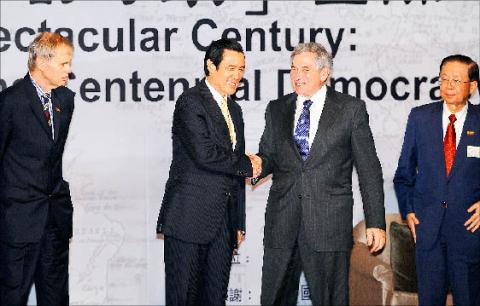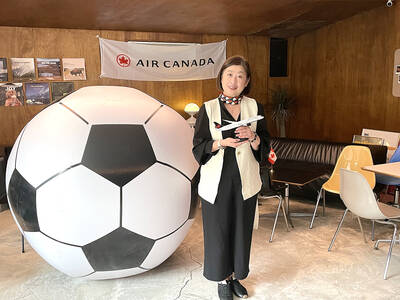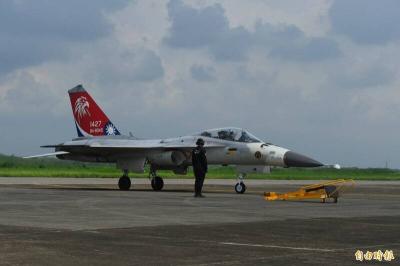Former American Institute in Taiwan (AIT) chairman Richard Bush said in Taipei yesterday that it is important to build a consensus in Taiwan about its core interests so that the country can face the challenges that lie ahead.
The former AIT head, who now serves as the director of the Center for Northeast Asia Policy Studies at the Brookings Institution, made the remark at an international conference titled “A Spectacular Century: The Republic of China (ROC) Centennial Democracy Forums.”
The two-day conference was organized by the Council for Cultural Affairs as part of a year-long celebration of the country’s 100th anniversary.

Photo: Liu Hsin-de, Taipei Times
Speaking on his essay “The Republic of China in Historical Perspective,” he said that Taiwan’s status is appropriate for modern governance, but “we may also ask about its capacity.”
“Does Taiwan have a proper evaluation of the coercive threat posed by the People’s Liberation Army [PLA] that is seriously expanding its war-fighting capabilities?” he asked. “Does Taiwan’s defense establishment, which properly shifted its mission from offense to defense decades ago, need to find ways to strengthen deterrence?”
He said that Taiwan faces tough decisions, such as how to achieve the goals of prosperity, social welfare and security simultaneously.
The toughest challenge of all, he said, is how to cope with a China that seeks to complete its mission of unification.
A local professor asked Bush how he thought Taiwan should deal with China’s unification mission.
Bush replied that he is working on a new book about the relationship between Taipei and Beijing and does not wish to give away the conclusion of his book. However, he did divulge one piece of advice: “I would say it is important to build a consensus on the island about what is truly important for the future of the people on this island.”
He asked participants to think about “what are the things that Taiwan can defend at all costs.” He said without consensus between opinions from both the green and blue spectrum, it is much harder to face that challenge.
Bush also clarified his two-China statement made at a conference in Washington last month.
“There is a huge misunderstanding,” he said. “I in no way advocated the two-China formula as the basis for resolving the disputes between the two sides.”
He said his statement was created by imaginative reporters and the two Chinas he was referring to was the thinking that US officials have accepted over the last 60 years in addressing the challenge of keeping the ROC in the UN.
Former World Bank chairman Paul Wolfowitz also gave a speech at the conference, in which he said that Taiwan is a model of democracy for China and that its economy and politics have had effects on China’s development.
The conference was also attended by Tien Hung-mao (田弘茂), president of the Institute for National Policy Research, and a number of foreign academics including Roderick MacFarquhar of Harvard University, Thomas Gold of California University of Berkeley, and Diana Lary from Canada’s University of British Columbia.

LOW RISK: Most nations do not extradite people accused of political crimes, and the UN says extradition can only happen if the act is a crime in both countries, an official said China yesterday issued wanted notices for two Taiwanese influencers, accusing them of committing “separatist acts” by criticizing Beijing, amid broadening concerns over China’s state-directed transnational repression. The Quanzhou Public Security Bureau in a notice posted online said police are offering a reward of up to 25,000 yuan (US$3,523) for information that could contribute to the investigation or apprehension of pro-Taiwanese independence YouTuber Wen Tzu-yu (溫子渝),who is known as Pa Chiung (八炯) online, and rapper Chen Po-yuan (陳柏源). Wen and Chen are suspected of spreading content that supported secession from China, slandered Chinese policies that benefit Taiwanese and discrimination against Chinese spouses of

PROMOTION: Travelers who want a free stopover must book their flights with designated travel agents, such as Lion Travel, Holiday Tours, Cola Tour and Life Tours Air Canada yesterday said it is offering Taiwanese travelers who are headed to North America free stopovers if they transit though airports in Japan and South Korea. The promotion was launched in response to a potential rise in demand for flights to North America in June and July next year, when the US, Canada and Mexico are scheduled to jointly host the FIFA World Cup, Air Canada said. Air Canada offers services to 13 of the 16 host cities of the tournament’s soccer games, including Toronto and Vancouver; Mexico City, Guadalajara and Monterrey in Mexico; Atlanta, Georgia; Boston; Dallas; Houston;

ALIGNED THINKING: Taiwan and Japan have a mutual interest in trade, culture and engineering, and can work together for stability, Cho Jung-tai said Taiwan and Japan are two like-minded countries willing to work together to form a “safety barrier” in the Indo-Pacific region, Premier Cho Jung-tai (卓榮泰) yesterday said at the opening ceremony of the 35th Taiwan-Japan Modern Engineering and Technology Symposium in Taipei. Taiwan and Japan are close geographically and closer emotionally, he added. Citing the overflowing of a barrier lake in the Mataian River (馬太鞍溪) in September, Cho said the submersible water level sensors given by Japan during the disaster helped Taiwan monitor the lake’s water levels more accurately. Japan also provided a lot of vaccines early in the outbreak of the COVID-19 pandemic,

The US approved the possible sale to Taiwan of fighter jet spare and repair parts for US$330 million, the Pentagon said late yesterday, marking the first such potential transaction since US President Donald Trump took office in January. "The proposed sale will improve the recipient's capability to meet current and future threats by maintaining the operational readiness of the recipient's fleet of F-16, C-130," and other aircraft, the Pentagon said in a statement. Trump previously said that Chinese President Xi Jinping (習近平) has told him he would not invade Taiwan while the Republican leader is in office. The announcement of the possible arms